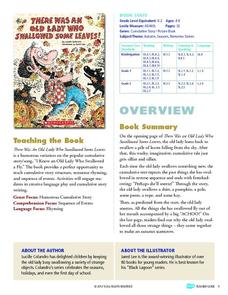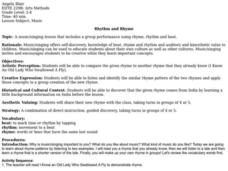Curated OER
I Know an Old Lady Who Swallowed a Fly
Preschoolers will love learning the song, " I Know an Old Lady Who Swallowed a Fly" with this PowerPoint. Each slide contains an image of an old lady and the animal she swallowed. Note: Audio does not appear to be working, however this...
Curated OER
There Was An Old Lady Who Swallowed Some Leaves Storia Teaching Guide
There was an old lady who swallowed some leaves? Little learners read a new version of the old swallow story with a fall twist as they try to answer the big question; Why is that lady swallowing all that weird stuff? The teacher's guide...
Curated OER
I Know an Old Lady
Young learners sing the song "I Know an Old Who Swallowed a Fly." They learn to track the words on a pocket chart and identify rhymes in the song as they are learning. Using illustrations, a flip chart, and the song, the teacher will...
Pennsylvania Department of Education
I Know An Old Lady Who Swallowed a Fly
Students listen to the story I Know An Old Lady Who Swallowed a Fly and practice using their listening skills to respond to the story. In this listening skills instructional activity, students use objects represented in the story and...
Curated OER
Rhythm and Rhyme
Students compare the given rhyme to another rhyme that they already know (I Know An Old Lady Who Swallowed A Fly). Students listen and identify the similar rhyme pattern of the two rhymes and apply those concepts to a group creation of...
Curated OER
Food Chain Pyramid
Second graders examine how a food chain functions. They define what a food chain is, and act out a food chain with the students acting as different animals. Students then sing the song "I Know An Old Lady Who Swallowed a Fly," and...
Curated OER
Rhythm and Rhyme
Students listen to and identify the similar rhyme pattern of two rhymes and apply those concepts to a group creation of a new rhyme. They discover that the given rhyme comes from India by learning a little background information on India.








